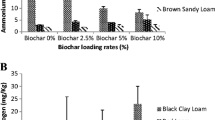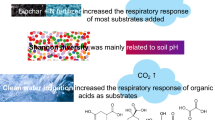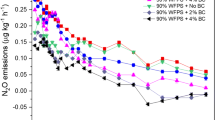Abstract
Field studies were conducted over 2 years to determine the response of soil microbial biomass pool to biochar and N fertilizer combinations in a rain-fed rice cropping system. Biochar was applied at four doses: 0 t ha−1, 3 t ha−1, 6 t ha−1 and 12 t ha−1 in combination with N fertilizer at four rates: 0 kg ha−1, 30 kg ha−1, 60 kg ha−1 and 90 kg ha−1 to a Typic Paleustalf Alfisol. Soil samples from two depths (0–10 and 10–20 cm) were collected to determine microbial biomass C (MBC), N (MBN), P (MBP), MBC/N ratio, MBC/P ratio, soil CO2 flux, microbial qCO2, cultivable bacterial and fungal abundance. Biochar and N fertilizer combination effects on MBC, MBN and MBP pools were dependent on biochar doses, N fertilizer rates and soil depth. MBC/N and MBC/P ratios were decreased after 2 years. Soil CO2 flux was maximum at post-seeding stage of rice plant, while decreasing trends occurred at active tillering and harvest stage. Increasing doses of biochar irrespective of its combination with N fertilizer rates decreased CO2 flux and microbial qCO2. Combinations of biochar and N fertilizer increased fungal/bacterial ratio and induced a shift to a more fungal-dominated population after 2 years. Our results suggest that combination of biochar doses (3–12 t ha−1) with N fertilizer rates had stimulatory effects on microbial biomass pools and activity with positive implications for organic carbon accumulation, nitrogen (N) and phosphorus (P) retention in tropical soils.




Similar content being viewed by others
References
Agegnehu G, Bass AM, Nelson PN, Bird MI (2016) Benefits of biochar, compost and biochar–compost for soil quality, maize yield and greenhouse gas emissions in a tropical agricultural soil. Sci Total Environ 543:295–306
Allen MF, Swenson W, Querejeta JI, Egerton-Warburton LM, Treseder KK (2003) Ecology of mycorrhizae: a conceptual framework for complex interactions among plants and fungi. Ann Rev Phytopathol 41:271–303
Allison VJ, Miller RM, Jastrow JD, Matamala R, Zak DR (2005) Changes in soil microbial community structure in a tallgrass prairie chronosequence. Soil Sci Soc Am J 69:1412–1421
Ameloot N, Sleutel S, Das KC, Kanagaratnam J (2015) Biochar amendment to soils with contrasting organic matter level: effects on N mineralization and biological soil properties. Glob Change Biol 7:135–144
Anderson TH, Domsch KH (1990) Application of eco-physiological quotients (qCO2 and qD) on microbial biomass from soils of different cropping histories. Soil Biol Biochem 22:251–255
Awopegba MS, Oladele S, Awodun M (2017) Effect of mulch types on nutrient composition, maize (Zea mays L) yield and soil properties of a tropical Alfisol in southwestern Nigeria. Eur J Soil Sci 6(2):121–133. https://doi.org/10.18393/ejss.286546
Barrow NJ, Shaw TC (1975) The slow reactions between soil and anions: effect of time and temperature on the decrease in phosphate concentration in the soil solution. Soil Sci 119:167–177
Black CA (1965) Methods of Soil Analysis Part 1 and 2. American Society of Agronomy Inc, Madison
Bougnom BP, Knapp BA, Elhottova D, Koubova A, Etoa FX, Insam H (2010) Designer compost with biomass ashes for ameliorating acid tropical soils: effects on the soil microbiota. Appl Soil Ecol 45:319–324
Bray RH, Kurtz L (1945) Determination of total organic, and available forms of phosphorus in soils. Soil Sci 59:39–46
Brookes PC, Landman A, Pruden G, Jenkinson DS (1985) Chloroform fumigation and the release of soil nitrogen: a rapid direct extraction method to measure microbial biomass nitrogen in soil. Soil Biol Biochem 17:837–842
Chan KY, Van Zwieten L, Meszaros I, Downie A, Joseph S (2007) Agronomic values of Green waste biochar as a soil amendment’. Austr J Soil Res 45:629–634
Chen J, Liu X, Zheng J, Zhang B, Lu H, Chi Z (2013) Biochar soil amendment increased bacterial but decreased fungal gene abundance with shifts in community structure in a slightly acid rice paddy from Southwest China. Appl Soil Ecol 71:33–44. https://doi.org/10.1016/j.apsoil.2013.05.003
Corbin JD, Avis PG, Wilbur RB (2003) The role of phosphorus availability in the response of soil nitrogen cycling, understory vegetation and arbuscular mycorrhizal inoculum potential to elevated nitrogen inputs. Water Air Soil Pollut 147:141–161
Covacevich F, Marino MA, Echeverría HE (2006) The phosphorus source determines the arbuscular mycorrhizal potential and the native mycorrhizal colonization of tall fescue and wheatgrass. Eur J Soil Biol 42:127–138
Deenik JL, McClellan T, Uehara G, Antal MJ, Campbell S (2010) Charcoal volatile matter content influence plant growth and soil nitrogen transformations. Soil Sci Soc Am J 74:1259–1270
Dempster DN, Gleeson DB, Solaiman ZM, Jones DL, Murphy DV (2011) Decreased soil microbial biomass and nitrogen mineralisation with Eucalyptus biochar addition to a coarse textured soil. Plant Soil 354:311–324
Drew EA, Murray RS, Smith SE (2006) Functional diversity of external hyphae of AM fungi: ability to colonize new hosts is influenced by fungal species, distance and soil conditions. Appl Soil Ecol 32:350–365
Egamberdieva D, Behrendt U, Abd-Allah EF, Berg G (2016) Biochar treatment resulted in a combined effect on soybean growth promotion and a shift in plant growth promoting Rhizobacteria. Front Microbiol 7:20–29
Epron D, Nouvellon Y, Roupsard O, Mouyondy W, Mabiala A, Saint-André L, Joffre R, Jourdan C, Bonnefond JM, Berbigier P, Hamel O (2004) Spatial and temporal variations of soil respiration in a Eucalyptus plantation in Congo. For Ecol Manag 202:149–160
Garcia C, Hernandez T, Roldan A, Martin A (2002) Effect of plant cover decline on chemical and microbiological parameters under mediterranean climate. Soil Biol Biochem 34:635–642
Gaur A, Adholeya A (2000) Effects of the particle size of soilless substrates upon AM fungus inoculum production. Mycorrhiza 10:43–48
Gerdemann JW, Nicolson TH (1963) Spores of mycorrhizal Endogone species extracted from soil by wet sieving and decanting. Trans Br Mycol Soc 46:235–244
Gómez JD, Denef K, Stewart CE, Zheng J, Cotrufo MF (2014) Biochar addition rate influences soil microbial abundance and activity in temperate soils. Eur J Soil Sci 65:28–39
Gryndler M, Larsen J, Hrselová H, Rezácová V, Gryndlerová H, Kubát J (2006) Organic and mineral fertilization, respectively, increase and decrease the development of external mycelium of arbuscular mycorrhizal fungi in a long-term field experiment. Mycorrhiza 16:159–166
Gul S, Whalen JK, Thomas BW, Sachdeva V, Deng H (2015) Physico-chemical properties and microbial responses in biochar amended soils: mechanisms and future directions. Agric Ecosyst Environ 206:46–59
Harrigan WF, McCanne ME (1990) Laboratory methods in medical mycology, 8th edn. London Academic Press, London, p 1621
He Y, Zhou X, Jiang L, Li M, Du Z, Zhou G, Shao J, Wang X, Xu Z, Hosseini Bai S (2016) Effects of biochar application on soil greenhouse gas fluxes: a meta-analysis. GCB Bioenergy 9:743–755
Hildebrandt U, Ouziad F, Marner FJ, Bothe H (2006) The bacterium Paenibacillus validus stimulates growth of the arbuscular mycorrhizal fungus Glomus intraradices up to the formation of fertile spores. FEMS Microbiol Lett 254:258–267
Hutchinson GL, Mosier AR (1981) Improved soil cover method for field measurement of nitrous oxide fluxes. Soil Sci Soc Am J 45:311–316
International Biochar Initiative (IBI) (2011) Standardized product definition and product testing guidelines for biochar that is used in soil. Accessed Nov 2017
International Institute of Tropical Agriculture (IITA) (2014) Upland rice production manual. www.iita.org. Accessed on 15 Oct 2016
Jin H (2010) Characterization of microbial life colonizing biochar and biochar amended soils. PhD Dissertation, Cornell University Ithaca, New York, USA. p 196
Jones DL, Rousk J, Edwards-Jones G, DeLuca TH, Murphy DV (2012) Biochar mediated changes in soil quality and plant growth in a three year field trial. Soil Biol Biochem 45:113–124
Kallenbach C, Grandy AS (2011) Controls over soil microbial biomass responses to carbon amendments in agricultural systems: a meta-analysis. Agric Ecosyst Environ 144:241–252
Kolb SE, Fermanich KJ, Dornbush ME (2009) Effect of charcoal quantity on microbial biomass and activity in temperate soils. Soil Sci Soc Am J 73:1173–1181
Kolton M, Meller Harel Y, Pasternak Z, Graber ER, Elad Y, Cytryn E (2011) Impact of biochar application to soil on the root-associated bacterial community structure of fully developed green house pepper plants. Appl Environ Microb 77:4924–4930. https://doi.org/10.1128/AEM.00148-11
Kushwaha CP, Tripathi SK, Singh KP (2000) Variations in soil microbial biomass and N availability due to residue and tillage management in a dryland rice agroecosystem. Soil Tillage Res 56:153–166
Lehmann J (2007) A handful of carbon. Nature 447:143–144
Lehmann J, Rondon M (2006) Bio-char soil management on highly weathered soils in the humid tropics. In: Uphoff N (ed) Biological approaches to sustainable soil systems. CRC Press, Boca Raton, pp 517–530
Lehmann J, Rillig MC, Thies J, Masiello CA, Hockaday WC (2011) Biochar effects on soil biota—a review. Soil Biol Biochem 43:1812–1836
Li Y, Wu J, Shen J, Liu S, Wang C, Chen D, Huang T, Zhang J (2016) Soil microbial C: n ratio is a robust indicator of soil productivity for paddy fields. Nat Sci Rep 6:35266. https://doi.org/10.1038/srep35266
Liang B, Lehmann J, Solomon D, Sohi S, Thies JE, Skjemstad JO, Luizão FJ, Engelhard MH, Neves EG, Wirick S (2008) Stability of biomass-derived black carbon in soils. Geochim Cosmochim Acta 72:6078–6096
Liang B, Lehmann J, Sohi SP, Thies JE, O’Neill B (2010) Black carbon affects the cycling of non-black carbon in soil. Organic Geochem 41:206–213
Lundquist EJ, Jackson LE, Scow KM, Hsu C (1999) Changes in microbial biomass and community composition and soil carbon and nitrogen pools after incorporation of rye into three California agricultural soils. Soil Biol Biochem 31:221–236
Maeder PA, Fliessbach D, Dubois L, Gunst P, Fried U (2002) Soil fertility and biodiversity in organic farming. Science 296:1694–1697
Matsubara YI, Hasegawa N, Fukui H (2002) Incidence of Fusarium root rot in asparagus seedlings infected with arbuscular mycorrhizal fungus as affected by several soil amendments. J Jpn Soc Hortic Sci 71:370–374
McLean EO (1982) Soil pH and lime requirement. In: Page, A.L. (Ed.), Methods of soil analysis. Chemical and microbiological properties. Part 2. Agronomy Series No. 9. ASA, SSSA, Madison, USA, pp. 199–234
Mohan D, Abhishek K, Sarswat A, Patel M, Singh P, Pittman CU (2018) Biochar production and applications in soil fertility and carbon sequestration–a sustainable solution to crop-residue burning in India. RSC Adv 8:508–520
Morel CH, Tiessen J, Stewart WB (1997) Correction for P- sorption in the measurement of soil microbial biomass P by chloroform fumigation. Soil Biol Biochem 29:1579–1583
Nakhro N, Dkhar MS (2010) Impact of organic and inorganic fertilizers on microbial populations and biomass carbon in paddy field soil. J Agron 9:102–110. https://doi.org/10.3923/ja.2010.102.110
Nelson DW, Sommers LE (1982) Total carbon, organic carbon and organic matter. In: Page AL (ed) Chemical and microbiological properties. Part 2. Agronomy Series No. 9. ASA, SSA, Madison, USA, pp 570
O’Neill B, Grossman J, Tsai MT, Gomes JE, Lehmann J (2009) Bacterial community composition in Brazilian Anthrosols and adjacent soils characterized using culturing and molecular identification. Microbial Ecol 58:23–35
Oberson A, Friesen DK, Morel C, Tiessen H (1997) Determination of phosphorus released by chloroform fumigation from microbial biomass in high P sorbing tropical soils. Soil Biol Biochem 299:1577–1583
Oladele S, Ayodele O (2017) Glyphosate, 1,1,-dimethyl-4,4-bipyridinium dichloride and Atrazine induces changes in soil organic carbon, bacterial and fungal communities in a tropical alfisol. Eur J Soil Sci 6(3):238–248
Oladele SO, Adeyemo AJ, Awodun MA (2019) Influence of rice husk biochar and inorganic fertilizer on soil nutrients availability and rain-fed rice yield in two contrasting soils. Geoderma 336:1–11. https://doi.org/10.1016/j.geoderma.2018.08.025
Paul EA, Clark FE (1989) Soil biology and biochemistry. Academic Press, San Diego, p 340p
Prayogo C, Jones JE, Baeyens J, Bending GD (2014) Impact of biochar on mineralisation of C and N from soil and willow litter and its relationship with microbial community biomass and structure. Biol Ferti Soils 50:695–702
Qz Zhang, Dijkstra FA, Xr Liu, Wang Yd, Huang J (2014) Effects of biochar on soil microbial biomass after four years of consecutive application in the north China plain. PLoS ONE 9(7):102–122. https://doi.org/10.1371/journal.pone.0102062
Rayment GE, Lyons DJ (2011) Alkaline earth carbonates. In: Rayment GE, Lyons DJ (eds) Soil chemical methods -Australasia. CSIRO Publishing, Melbourne, pp 415–425
Rondon MA, Lehmann J, Ramirez J, Hurtado M (2007) Biological nitrogen fixation by common beans (Phaseolus vulgaris L.) increases with biochar additions. Biol Fert Soil 43:699–708
SAS Institute Inc (2008) SAS/STAT 9.2 User’s Guide. SAS Institute Inc., Cary, NC, USA
Shi PL, Zhang XZ, Zhong ZM, Ouyang H (2006) Diurnal and seasonal variability of soil CO2 efflux in a cropland ecosystem on the Tibetan Plateau. Agric For Meteorl 137:220–233
Six J, Frey SD, Thiet RK, Batten KM (2006) Bacterial and fungal contributions to carbon sequestration in agroecosystems. Soil Sci Soc Am J 70:555–569
Smith SE, Read DJ (2008) Mycorrhizal Symbiosis. Springer, Berlin, p 106
Smith JL, Collins HP, Bailey VL (2010) The effect of young biochar on soil respiration. Soil Biol Biochem 42:2345–2347
Srivastava P, Singh R, Bhadouria R, Tripathi S, Singh P, Singh H, Raghubanshi AS (2016a) Organic amendment impact on SOC dynamics in dry tropics: a possible role of relative availability of inorganic N-pools. Agric Ecosys Environ 235:38–50
Srivastava P, Singh PK, Singh R, Bhadouria R, Singh DK, Singh S, Afreen T, Tripathi SN, Singh P, Singh H, Raghubanshi AS (2016b) Relative availability of inorganic N-pools shifts under land use change: an unexplored variable in soil carbon dynamics. Ecol Ind 64:228–236
Srivastava P, Singh R, Tripathi S, Singh H, Raghubanshi AS, Mishra PK (2017) A new insight into the warming potential of organically amended agro-ecosystems. Org Agric 8:1–10. https://doi.org/10.1007/s13165-017-0188-4
Stahl PD, Christensen M (1982) Mycorrhizal fungi associated with Bouteloua and Agropyron in Wyoming Sagebrush grass. Mycologia 74(6):85–91
Steiner C, Das KC, Garcia M, Forster B, Zech W (2008) Charcoal and smoke extract stimulate the soil microbial community in a highly weathered xanthic Ferralsol. Pedobiologia 51:359–366
Sullivan BW, Dore S, Kolb TE, Hart SC, Montes-Helu C (2010) Evaluation of methods for estimating carbon dioxide efflux across a gradient of forest disturbance. Global Clim Biol 16:2449–2460
Suman A, Lal ML, Singh AK, Gaur A (2006) Microbial biomass turnover in Indian subtropical soils under different sugarcane intercropping systems. Agron J 98:698–704
Thies JE, Rillig MC (2009) Characteristics of biochar: biological properties. In: Lehmann J, Joseph S (eds) Biochar for Environmental Management: Science and Technology. Earthscan Publications, Dunstan House, London, pp 85–105
Walkley A, Black IA (1945) An examination of the Degtjareff method for determining soil organic matter, and a proposed modification of the chromic acid titration method. Soil Sci 37:29–38
Wallstedt A, Coughlan A, Munson AD, Nilsson MC, Margolis HA (2002) Mechanisms of interaction between Kalmia angustifolia cover and Picea mariana seedlings. Can J For Res 32:2022–2031
Wardle DA, Nilsson MC, Zackrisson O (2008) Fire-derived charcoal causes loss of forest humus. Science 320:629
Warnock DD, Lehmann J, Kuyper TW, Rillig MC (2007) Mycorrhizal responses to biochar in soil—concepts and mechanisms. Plant Soil 300:9–20. https://doi.org/10.1007/s11104-007-9391-5
Woolf D, Amonette JE, Street-Perrott FA, Lehmann J, Joseph S (2010) Sustainable biochar to mitigate global climate change. Nat Commun 1:56
Wu J (2007) Dynamics in microbial immobilization and transformations of phosphorus in highly weathered subtropical soil following organic amendments. Plant Soil 290(1):333–342
Wu J, Joergensen RG, Pommerening B, Chaussod R, Brookes PC (1990) Measurement of soil microbial biomass C by fumigation-extraction—an automated procedure. Soil Biol Biochem 22:1167–1169
http://www.biochar-international.org/characterization-standard
Yamato M, Okimori Y, Wibowo IF, Anshiori S, Ogawa M (2006) Effects of the application of charred bark of Acacia mangium on the yield of maize, cowpea and peanut, and soil chemical properties in South Sumatra, Indonesia. Soil Sci Plant Nutr 52:489–495
Yu XY, Ying GG, Kookana RS (2006) Sorption and desorption behaviors of diuron in soils amended with charcoal. J. Agric Food Chem 54:8545–8550
Zackrisson O, Nilsson MC, Wardle DA (1996) Key ecological function of charcoal from wildfire in the Boreal forest. Oikos 77:10–19
Zhang Y, Lin F, Wang X, Zou J, Liu S (2016) Annual accounting of net greenhouse gas balance response to biochar addition in a coastal saline bioenergy cropping system in China. Soil Tillage Res 158:39–48
Author information
Authors and Affiliations
Corresponding author
Ethics declarations
Competing interests
The authors have declared that no competing interests exist.
Electronic supplementary material
Below is the link to the electronic supplementary material.
Rights and permissions
About this article
Cite this article
Oladele, S., Adeyemo, A., Adegaiye, A. et al. Effects of biochar amendment and nitrogen fertilization on soil microbial biomass pools in an Alfisol under rain-fed rice cultivation. Biochar 1, 163–176 (2019). https://doi.org/10.1007/s42773-019-00017-2
Received:
Accepted:
Published:
Issue Date:
DOI: https://doi.org/10.1007/s42773-019-00017-2




